Disability discrimination in the workplace: How companies can prevent it and what employees can do if it happens
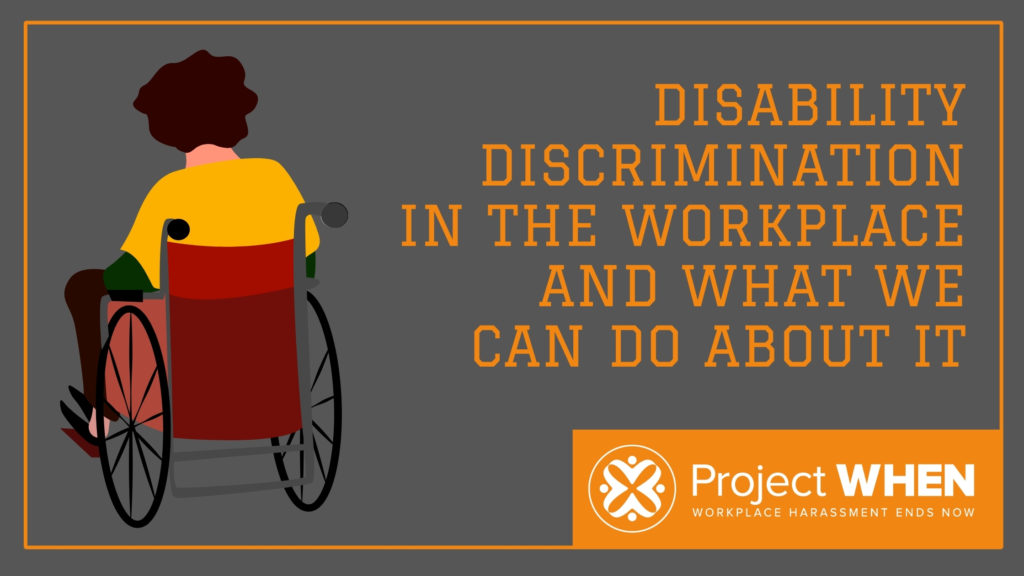
Awareness against disability discrimination
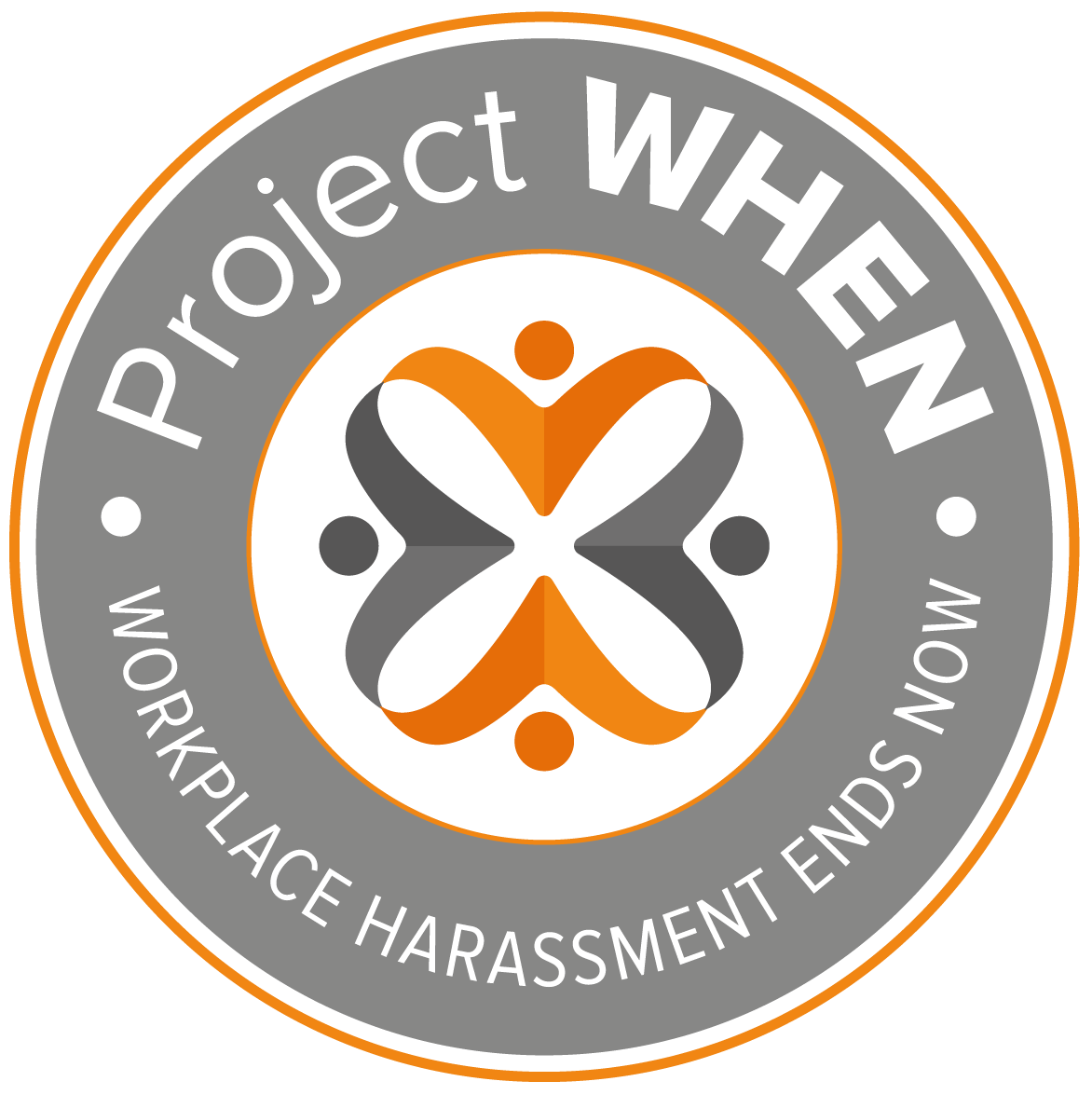 Do you feel that you are a victim of disability discrimination or have you observed it happening in your workplace? Let’s explore some facts that you should know in order to handle it.
Do you feel that you are a victim of disability discrimination or have you observed it happening in your workplace? Let’s explore some facts that you should know in order to handle it.
Our mission at Project WHEN (Workplace Harassment Ends Now) is to elevate awareness to eliminate harassment and create more respectful workplaces. This post on disability discrimination is part of our series of pages educating the public about various types of workplace harassment, how employers can prevent it, and employees’ rights under the law.
What is disability discrimination?
Disability discrimination in the workplace occurs when a person is treated less favorably on the basis of his/her disability. It manifests in aspects of employment (hiring, firing, layoff, pay, benefits, promotion, etc.) or harassment (harassing a person either with derogatory remarks or actions in relation to his/her disability).
In this post, we’ll touch on the history of disability discrimination, the laws offering protection from discrimination against the disabled, and the recourse victims of disability harassment have under the law.
Importantly, we’ll also cover what employers can do to prevent disability discrimination in the workplace, along with delving into what companies should do when an incident of disability discrimination takes place. You’ll also find a number of resources we feel are helpful for those dealing with disability discrimination.
The history of disability discrimination in the workplace
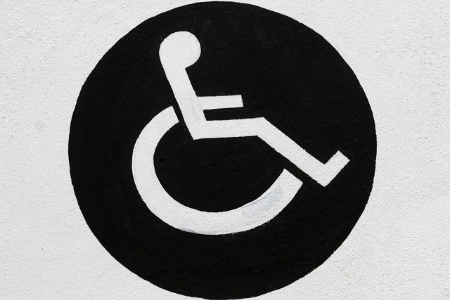 People with disabilities have a long history of oppression and discrimination. Historically, because of their perceived difference than everyone else, they have been ridiculed and marginalized in society. From the absence of ramps and intentional public isolation, the unjust treatment has made life harder for them.
People with disabilities have a long history of oppression and discrimination. Historically, because of their perceived difference than everyone else, they have been ridiculed and marginalized in society. From the absence of ramps and intentional public isolation, the unjust treatment has made life harder for them.
Deprived of specific human rights, it has been difficult for these individuals to enjoy the same quality of life that others have, which involves the privilege of employment. In the 1860s, some cities across the United States even went as far as enacting ordinances known as “ugly laws” which were passed to rid public places of any person described as “unsightly or disgusting.” This intensified the alienation of people with disabilities.
The fire burning within advocates of disability rights started to stir change in the 1970s. More and more people began to gain courage and demand for equal treatment. The continuous protests and efforts to raise awareness prompted the government to pay attention to this pressing issue.
These events led to the enactment of the Americans with Disabilities Act of 1990 (which will be discussed further in this article). The law opened doors for people with disabilities in many aspects including employment. But somehow, discrimination can still be observed in the corporate world.
Statistics on disability discrimination
In 2019, there were 24,238 disability discrimination charges filed and resolved with the U.S. Equal Employment Opportunity Commission (EEOC). This does not include data from state or local Fair Employment Practices Agencies.
This figure alone shows that disability discrimination still persists in today’s era. To combat this pervasive behavior, it is important to know the facts about what the law says about disability discrimination. Read on to explore what laws protect you from being discriminated against because of your disability, as well as key actions to take by both companies and victims in dealing with this type of discrimination.
Disability discrimination laws
Federal Laws
Americans with Disabilities Act (ADA)
Formally signed by President George W. Bush in 1990, the Americans with Disabilities Act has been providing protection for individuals with disabilities for decades now. This Act has undergone changes when Congress enacted a new law known as the Americans with Disabilities Act Amendments Act of 2008. These changes were done to make it easier for victims to gain access to protection under the ADA.
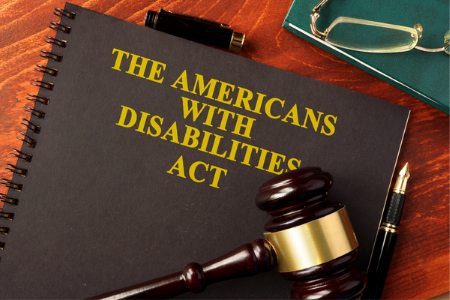 Under this law, it is illegal for an employer to discriminate against an applicant or employee on the basis of disability. As long as it does not cause a significant loss or difficulty, employers are required to provide assistance to people with disabilities and enable them to apply for a job or do their jobs and responsibilities. For instance, if a person’s disability requires a specific rest schedule, a possible accommodation could be offering flexibility in their work hours.
Under this law, it is illegal for an employer to discriminate against an applicant or employee on the basis of disability. As long as it does not cause a significant loss or difficulty, employers are required to provide assistance to people with disabilities and enable them to apply for a job or do their jobs and responsibilities. For instance, if a person’s disability requires a specific rest schedule, a possible accommodation could be offering flexibility in their work hours.
The ADA also makes it unlawful to harass an applicant or employee because of their perceived disability. Harassment can take the form of humiliation or derogatory remarks. It is important to note, however, that incidents that are not very serious (such as simple one-time teasing) may not be considered illegal. Severe cases that create a threatening work environment or cause someone to be fired or demoted are what makes the act illegal.
Once an act of discrimination occurs, victims have 180 days to file a charge. It is recommended to cross-check with state policies to know if this time limit can be extended. Project WHEN’s guide, How to Report Workplace Harassment Incidents, is a good starting point for accessing state and local websites that either house this information or can quickly get you an answer on timing.
Who is covered by the ADA? The legal requirements apply to private, state and local employers, labor organizations, employment agencies, and labor-management committees with 15 or more employees. For victims, it is important to take note of how the law defines “disability.”
Below is a section from Chapter 126—Equal Opportunity for Individuals with Disabilities from the ADA of 1990, as amended. This section shows the definition of “disability” in the context of the law. The full text can be found here.
| Americans with Disabilities Act:
SEC. 12102. DEFINITION OF DISABILITY As used in this chapter: (1) Disability The term “disability” means, with respect to an individual (A) a physical or mental impairment that substantially limits one or more major life activities of such individual; (B) a record of such an impairment; or (C) being regarded as having such an impairment (as described in paragraph (3)). (2) Major Life Activities (A) In general For purposes of paragraph (1), major life activities include, but are not limited to, caring for oneself, performing manual tasks, seeing, hearing, eating, sleeping, walking, standing, lifting, bending, speaking, breathing, learning, reading, concentrating, thinking, communicating, and working. (B) Major bodily functions For purposes of paragraph (1), a major life activity also includes the operation of a major bodily function, including but not limited to, functions of the immune system, normal cell growth, digestive, bowel, bladder, neurological, brain, respiratory, circulatory, endocrine, and reproductive functions. (3) Regarded as having such an impairment For purposes of paragraph (1)(C): (A) An individual meets the requirement of “being regarded as having such an impairment” if the individual establishes that he or she has been subjected to an action prohibited under this chapter because of an actual or perceived physical or mental impairment whether or not the impairment limits or is perceived to limit a major life activity. (B) Paragraph (1)(C) shall not apply to impairments that are transitory and minor. A transitory impairment is an impairment with an actual or expected duration of 6 months or less. (4) Rules of construction regarding the definition of disability The definition of “disability” in paragraph (1) shall be construed in accordance with the following: (A) The definition of disability in this chapter shall be construed in favor of broad coverage of individuals under this chapter, to the maximum extent permitted by the terms of this chapter. (B) The term “substantially limits” shall be interpreted consistently with the findings and purposes of the ADA Amendments Act of 2008. (C) An impairment that substantially limits one major life activity need not limit other major life activities in order to be considered a disability. (D) An impairment that is episodic or in remission is a disability if it would substantially limit a major life activity when active. (E) (i) The determination of whether an impairment substantially limits a major life activity shall be made without regard to the ameliorative effects of mitigating measures such as (I) medication, medical supplies, equipment, or appliances, low-vision devices (which do not include ordinary eyeglasses or contact lenses), prosthetics including limbs and devices, hearing aids and cochlear implants or other implantable hearing devices, mobility devices, or oxygen therapy equipment and supplies; (II) use of assistive technology; (III) reasonable accommodations or auxiliary aids or services; or (IV) learned behavioral or adaptive neurological modifications. (ii) The ameliorative effects of the mitigating measures of ordinary eyeglasses or contact lenses shall be considered in determining whether an impairment substantially limits a major life activity. (iii) As used in this subparagraph (I) the term “ordinary eyeglasses or contact lenses” means lenses that are intended to fully correct visual acuity or eliminate refractive error; and (II) the term “low-vision devices” means devices that magnify, enhance, or otherwise augment a visual image. |
Rehabilitation Act of 1973
This law offers the same protections and provisions as the ADA. However, it is specific to Federal agencies, in programs receiving Federal financial assistance, in Federal employment, and in the employment practices of Federal contractors.
State Laws
Aside from federal laws, most states enforce laws that protect people with disabilities. Some policies may have different requirements than the ADA. The best way to learn more about additional protections you can receive locally is to refer to your state’s department of labor website. Our guide on reporting incidents of workplace harassment links to each state’s DOL website, as well as some of the regional and city organizations, for those in more populous areas.
Recourse for victims of disability discrimination
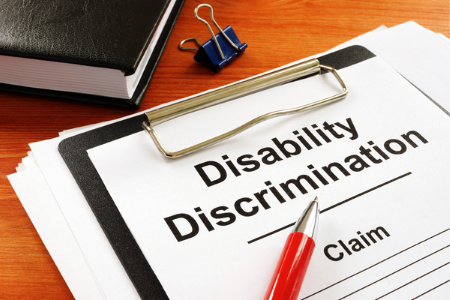 If you think you or a colleague is suffering disability discrimination, you have the right to seek legal recourse. If you have already reported it to your company’s HR and you are not seeing any signs of moving forward, you have the option to consult legal counsel or an employment lawyer. These professionals can help you evaluate the case and provide valuable advice regarding your claims.
If you think you or a colleague is suffering disability discrimination, you have the right to seek legal recourse. If you have already reported it to your company’s HR and you are not seeing any signs of moving forward, you have the option to consult legal counsel or an employment lawyer. These professionals can help you evaluate the case and provide valuable advice regarding your claims.
A best next step could also be filing a charge either through your state administrative agency or the EEOC, a federal agency that enforces federal laws related to harassment and discrimination in the workplace. You are not required to speak with an attorney before approaching a government agency to discuss your situation; these entities are in place to protect your rights as an employee and are typically willing to give guidance on suggested next steps for you as a victim.
To know about the process of reporting disability discrimination cases, refer to our full guide on How to Report Workplace Harassment Incidents. This article provides a comprehensive list of state resources and local U.S. Equal Employment Opportunity Commission offices. You can also head directly to the EEOC’s page on How to File a Charge of Employment Discrimination.
What can companies do to prevent disability discrimination?
The primary action that companies should actively take in order to prevent disability discrimination is to follow the requirements set forth by the law. This can include reasonable accommodations or adjustments as explained earlier in this post.
You may also benefit from studying what you can or cannot ask during an interview. One important thing to remember is that the ADA requires employers to post a notice describing the provisions of the Act. This notice must be accessible to applicants and all members of the organization.
The advocacy to prevent this type of discrimination is most effective when the initiative starts with senior leadership, but sometimes change takes one individual who has the courage to speak up. If you are passionate about ensuring the safety of employees from the different manifestations of discrimination, consider getting your company involved with Project WHEN (Workplace Harassment Ends Now).
As a first step, we’d ask you to sign our Pledge of Commitment to demonstrate your commitment to creating a respectful, harassment-free workplace for your employees.
For a holistic and structured approach to living out your commitment, we would encourage you to enroll in the WHEN™ Organizational Certification program. In this program, we will guide you through a step-by-step process of preventing all types of workplace harassment. This certification will also serve as a powerful statement to both internal and external audiences about your commitment to making your workplace a safe space for everyone. The Employee Culture Pulse Survey, which is also offered as a standalone service, will be administered to employees in the first phase of this program. The actionable data gained from this survey will allow you to identify challenges in your fight against workplace harassment and strategize your path to improvement.
What should companies do when disability discrimination happens?
 Acts of discrimination will only happen when companies lack awareness and implementation of preventive measures. When tell-tale signs of hostility are observed within the organization, it is time to start dismantling it by engaging in meaningful conversations and breaking the status quo.
Acts of discrimination will only happen when companies lack awareness and implementation of preventive measures. When tell-tale signs of hostility are observed within the organization, it is time to start dismantling it by engaging in meaningful conversations and breaking the status quo.
If you are ready to begin discussions on creating a more respectful work environment, we can facilitate a Project WHEN Roundtable. This event can help attendees identify challenges present in their current working conditions and gain insight on the best action steps to eliminate traces of discrimination in the workplace.
If you are an individual who thinks that it is time to see change happening in your company, let your employer know about this and ask for a facilitated discussion to take place.
Remember, the problem will not solve itself. It is important for everyone to develop heightened awareness of what they can do to make a difference. Change will only take place if people within the workplace take the initiative to address issues, no matter how uncomfortable it may be.
Additional resources and recommended readings
For more information about disability discrimination, we’ve rounded up some resources that you can consult and find below.
- Disability Discrimination | U.S. Equal Employment Opportunity Commission
- The ADA: Your Responsibilities as an Employer
- The ADA: Your Employment Rights as an Individual With a Disability
- ADA – Fighting Discrimination in Employment Under the ADA
- Your Legal Disability Rights
End disability discrimination now
Nobody should have to face disability discrimination or any form of harassment, for that matter. Project WHEN is a 501(c)(3) nonprofit organization working hard to make workplaces more respectful for everyone. Elevating awareness to prevent workplace harassment from taking place is what runs at the core of our organization.
Whether you’d like to make a financial contribution to support our work, sign the Project WHEN Pledge of Commitment, have your employer host a Project WHEN event, or just join our mailing list to learn of volunteer opportunities, everyone can get involved with Project WHEN!

